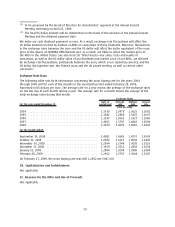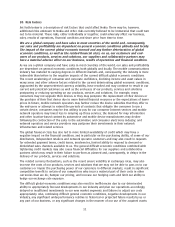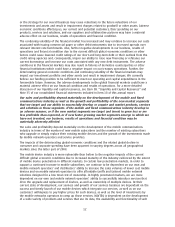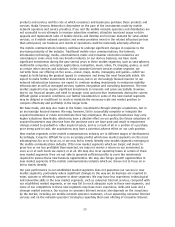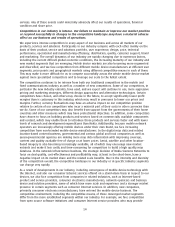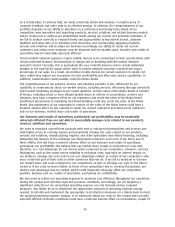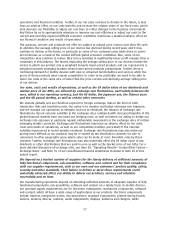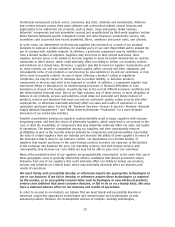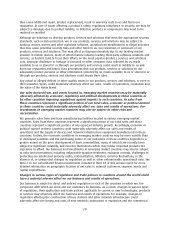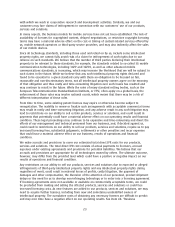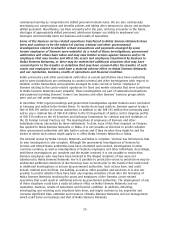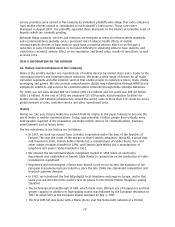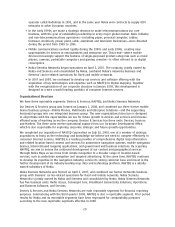Nokia 2008 Annual Report Download - page 21
Download and view the complete annual report
Please find page 21 of the 2008 Nokia annual report below. You can navigate through the pages in the report by either clicking on the pages listed below, or by using the keyword search tool below to find specific information within the annual report.thus cause additional repair, product replacement, recall or warranty costs to us and harm our
reputation. In case of issues affecting a product’s safety, regulatory compliance or security, we may be
subject to damages due to product liability, or defective products or components may need to be
replaced or recalled.
Although we endeavor to develop products, services and solutions that meet the appropriate security
standards, such as data protection, we or our products, services and solutions may be subject to
hacking, viruses, worms and other malicious software, unauthorized modifications or illegal activities
that may cause potential security risks and other harm to us, our customers or endusers of our
products, services and solutions. This may affect us disproportionately due to our leading market
position in mobile devices, many of which feature industry leading thirdparty software solutions and
services, as hackers tend to focus their efforts on the most popular products, services and solutions.
Loss, improper disclosure or leakage of personal or other consumer data collected by us, made
available to us or stored to or through our products and services could result in liability to us and
harm our reputation and brand. Even perceptions that our products, services or solutions do not
adequately protect personal or other information collected by us, made available to us or stored in or
through our products, services and solutions could impair their sales.
Any actual or alleged defects or other quality issues in our products, services and solutions, or even in
their unlawful copies, could materially adversely affect our sales, results of operations, reputation and
the value of the Nokia brand.
Our sales derived from, and assets located in, emerging market countries may be materially
adversely affected by economic, regulatory and political developments in those countries or
by other countries imposing regulations against imports to such countries. As sales from
these countries represent a significant portion of our total sales, economic or political turmoil
in these countries could materially adversely affect our sales and results of operations. Our
investments in emerging market countries may also be subject to other risks and
uncertainties.
We generate sales from and have manufacturing facilities located in various emerging market
countries. Sales from these countries represent a significant portion of our total sales and these
countries represent a significant portion of any expected industry growth. Accordingly, economic or
political turmoil in these countries could materially adversely affect our sales and results of
operations and the supply of devices and network infrastructure equipment manufactured in these
countries. Further, the economic conditions in emerging market countries may be more volatile than
in developed countries and the purchasing power of our customers in those countries depends to a
greater extent on the price development of basic commodities, many of which have recently been
subject to significant volatility, and currency fluctuations which may render imported products too
expensive to afford. Our business and investments in emerging market countries may also be subject
to risks and uncertainties, including unfavorable taxation treatment, exchange controls, challenges in
protecting our intellectual property rights, nationalization, inflation, currency fluctuations, or the
absence of, or unexpected changes in, regulation as well as other unforeseeable operational risks. See
Note 2 to our consolidated financial statements included in Item 18 of this annual report for more
detailed information on geographic location of net sales to external customers, segment assets and
capital expenditures.
Changes in various types of regulation and trade policies in countries around the world could
have a material adverse effect on our business and results of operations.
Our business is subject to direct and indirect regulation in each of the countries in which we, the
companies with which we work and our customers do business. As a result, changes in various types
of regulations, their application and trade policies applicable to current or new technologies, products
or services may adversely affect our business and results of operations. For example, changes in
regulation affecting the construction of base stations and other network infrastructure could
adversely affect the timing and costs of new network construction or expansion and the commercial
20


